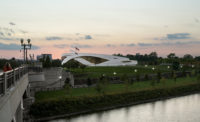As the work of rebuilding Nepal in the aftermath of the 2015 earthquakes continues, construction has begun on a unique project in the village of Phortse, a farming community that is home to many veteran Everest sherpas. The Teahouse, designed by London-based Denizen Works for the Little Sherpa Foundation, a charity that helps the children of guides who have died while working on the mountain, will serve as both hostel and community center, with proceeds supporting the charity’s work.
Local buildings, whose brightly colored metal roofs dot the village’s terraced slope, are constructed predominantly of stone. More than half were damaged or levelled in the quakes. “I wondered if it was possible to build an earthquake-resistant and eco-friendly building which local people could afford,” says James Lamb, a Scottish mountaineer who established the Little Sherpa Foundation in collaboration with Tashi Lama, a Nepalese monk. “Our hope is to produce a building inspirational to locals and tourists alike, which will also demonstrate an alternative method of building in this area.”
The design conceives of the main accommodation block as an inhabitable wall that edges the site’s south and west boundaries and frames a sheltered courtyard for the meditation center. A communal dining hall forms the site’s northern edge, with the east exposure open to views of the Himalayas. “The buildings seek to reinterpret recognizable local forms and materials into a contemporary architectural language to complement the setting,” says Murray Kerr, director of Denizen Works.
Instead of stone walls, the accommodation and dining blocks—seismic-resistant structures of local timber—are clad in the same metal as the roof. This cladding, with small, deep-set windows, presents a rugged face to the harsh landscape, while a colonnade wraps the protected, wood-clad courtyard elevation.
The form of the central meditation space refers to the stupas, mound-shaped Buddhist monuments, found throughout Nepal. It consists of a single, 25-foot-tall volume, the concrete shell of which is perforated by small, clustered apertures, open to the elements to heighten users’ connection to the outside.
“The challenge for the structure was to enable an architecturally interesting form that must also resist seismic loading and be built with relatively low-tech methods in a very remote area,” says Tim Lucas, a partner at London-based Price & Myers, the structural engineers for the project. Steel tubes will be transported to the site by helicopter and yak, and be bolted together using geodesic geometry to form a reliable frame. Construction is expected to be complete in November.
“I have no doubt that during another earthquake locals will flock to the building,” says Lamb. “We would welcome that.”













Post a comment to this article
Report Abusive Comment